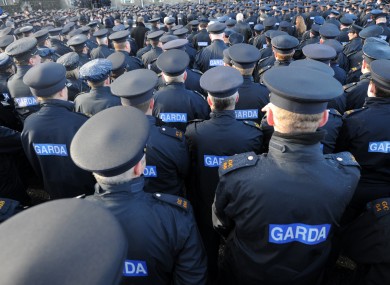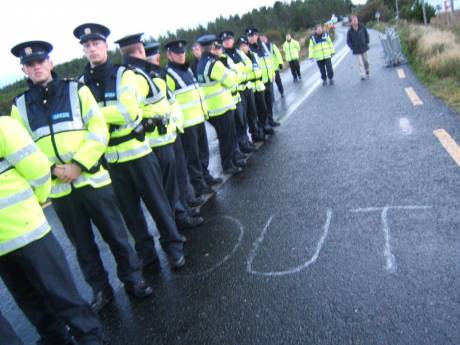Record numbers of Irish people in poverty, CSO figures show


Fr Sean Healy challenged the government in failing to tackle the ‘working poor’
Over 700,000 people are in poverty across the State according to figures published by the Central Statistic Office (CSO) today.
The latest analysis of the poverty statistics published by the CSO shows that the number of people in poverty has now reached a record level of 733,000.
Social Justice Ireland has challenged the Government in failing to tackle what they describe as the “working poor” and those depending on social welfare payments.
“The increase in the proportion of Ireland’s population at risk of poverty, from 14.7 per cent to 16 per cent in one year, clearly identifies a major policy failure by Government which has imposed a disproportionate part of the ‘hit’ for current budgetary adjustments on Ireland’s poor and vulnerable people.
The Government should give priority to ensuring that everyone in Ireland has the income and services to live life with basic dignity, which is not currently the case,” said director of Social Justice Ireland Fr Seán Healy,
The CSO figures show that more than 232,000 children are at risk of poverty, representing18.8 per cent of all children, compared to 18.4 per cent a year earlier.
One in seven (14.2 per cent) of all those at risk of poverty has a job, the figures show. Without social welfare payments, over half (50.7 per cent) of the population would be at risk of poverty.
(GRA) Gardai consider an uniformed protest march


The attendance of gardai at an anti-Government rally in their uniforms would represent a challenge to the authority of Garda Commissioner Martin Callinan.
The Garda Representative Association (GRA) has suggested that gardaí break regulations and attend a rally next week against pay cuts dressed in their uniforms.
The move would be a major embarrassment for the Government and would put the association, which represents 11,300 rank and file gardaí in a force of 13,400, on a major collision course with Minister for Justice Alan Shatter.
He would be forced to intervene to block the move or to penalise those involve if it went ahead. However, Mr Shatter would find it very difficult to identify, and have a disciplinary process begun against, a large number of gardaí.
It would also leave him open to the charge that he had lost control of the force.
The attendance of gardaí at an anti-Government rally in their uniforms would also represent a challenge to the authority of Garda Commissioner Martin Callinan. Part of the oath sworn by gardaí when they assume their full Garda powers after training is to remain apolitical.
The idea to rally in uniform at a protest next Monday was mooted yesterday at a behind-closed-doors meeting of the national executives of unions and representative bodies of those frontline and emergency workers aligned to the 24/7 Frontline Services Alliance.
They include Garda members, nurses, psychiatric nurses, fire fighters and prison officers. There are two Garda bodies in the alliance, namely the GRA and the Association of Garda Sergeants and Inspectors (Agsi).
The GRA put forward the idea that gardai in uniform would attend the rally at the Basket Arena, Tallaght, Dublin, next Monday night. It is being organised by the 24/7 alliance as a form of protest against proposed pay cuts, specifically against cuts to premium pay.
Informed sources said the level of militancy within the ranks of the Garda over reduced remuneration and resources was at an all time high and that the GRA leadership is being put under pressure by its membership to take a harder line.
Other sources said while the suggestion by the organisation that its members would attend in uniforms represented the GRA taking such a hardened approach, they doubted if the proposal would come to fruition.
The same sources said all frontline workers may wear 24/7 Alliance caps rather than rally dressed in different uniforms.
A spokesman for the GRA said he did not believe gardai would rally in their uniforms. When asked if senior people in the association wanted those in attendance to wear their Garda uniforms he said he could not comment.
The Association’s national executive this morning began its two-day monthly meeting in Dublin. It is gathering against a backdrop in the past fortnight of a number of local meetings at which members passed votes of no confidence in Mr Shatter and Commissioner Callinan.
Members also voted at local meetings in favour of industrial action, which they are banned from undertaking, and in favour of work-to-rule protests.
While gardaí are permitted to attend events when they are off duty and in their civilian clothes, they are strictly forbidden from attending any event in their uniforms even when off duty.
Members of the force are banned from joining political parties and last year a request was declined to let a small number of gay and lesbian gardaí take part in the Pride march in Dublin dressed in their uniforms.
Garda management believed such participation could be regarded as political and they also felt it would be confusing to have gardaí in uniform taking part in a parade that would be policed by other members in uniform.
The only event gardaí have attended dressed in uniforms has been St. Patrick’s Day parades in the US, when the regulations have been relaxed because those events have been outside the State.
The last time the GRA became involved in a similar plan was in 2006 when it threatened to campaign against Government TDs in marginal seats in the general election.
In a row over the introduction of the Garda reserve, it said it would be “waiting in the long grass” during the election and would encourage others to vote against five Fianna Fail-PD government TDs with slim majorities at previous elections.
However, then minister for justice Michael McDowell and then garda commissioner Noel Conroy reacted furiously to the plan and the association effectively backed down with 24 hours.
Mr McDowell warned gardaí to stay out of politics. Garda Commissioner Noel Conroy said all members had taken an oath to be apolitical and he said he would sanction any garda who broke this oath.
How second-hand smoke affects people and you


There is need for a law to regulate usage of tobacco, especially to protect both smokers and non smokers from the adverse effects of smoking such as cancer and heart disease.
If you are like many people who do not like the smell of tobacco, you will most likely hold your breath while passing by a person who is smoking.
Unlike this priviledge you have and might take for granted, Mr Sean Carroll could not afford to do such a thing. A website tobaccoinaustralia.org.au tells a story of the bus driver in Australia, who did not have a choice. Every day of his life for the 36 years he had the job, he had to drive a bus that had no restrictions on smoking. As a result, Carroll, a non-smoker developed lung cancer from years of passive exposure to tobacco smoke. He sued his employer, the Melbourne Metropolitan Transit Authority. The case was settled out of court, he was compensated $65,000 (Shs173.2m). But we all know this could not be compared to the life he was going to live with lung cancer.
Mr Carroll’s condition was one of the side effects of second hand smoking. Uganda’s law on smoking in public places defines second hand smoke as the smoke exhaled from a person smoking a tobacco product, and includes side-stream smoke which the law defines as the smoke of other emissions released from a tobacco product or the smoke exhaled by a person smoking a tobacco product.
Because little attention has been given to the damage tobacco poses, especially on the passive smoker who does not use it, in Uganda, there is limited documentation of such cases.
Mr Andrew Kwizeera, a member of Campaign for Tobacco Free Kids, says since the fight for the control of tobacco usage in Uganda is new, “There is limited documentation and most of what we have is just recent. But global statistics show that 600,000 people globally are exposed to second hand smoke and in adults, it causes serious cardiovascular and respiratory diseases, including coronary heart disease and lung cancer. In infants, it causes sudden death while in pregnant women, it causes low birth weight.”
Ms Christine Namulindwa, the public relations officer of the Uganda Cancer Institute, says, “The ratio of patients who present with lung cancer at the institute as a result of secondhand smoking is one out of 10.”
The law on public smoking in Uganda
Lung cancer and other side effects of smoking on the non-smokers were raised by the Ugandan public in the early 2000s and this saw the government formulating the National Environment (Control of Smoking in Public Places) Regulations 2004. This is the law being “observed” in Uganda as regards public smoking.
Lung cancer and other side effects of smoking on the non-smokers were raised by the Ugandan public in the early 2000s and this saw the government formulating the National Environment (Control of Smoking in Public Places) Regulations 2004. This is the law being “observed” in Uganda as regards public smoking.
Besides the pressure from the public, this law was formulated as a follow-up on Uganda’s signing of the World Health Organisation’s Framework Convention on Tobacco Control. Formulated by the National Environment Management Authority (Nema), the 11-paged legislation highlights certain issues.
Article 4 states, “No person shall smoke a tobacco product or hold a lighted tobacco product in an enclosed, indoor area of a public place.”
Article 6(1) indicates that, “No person shall smoke in any public service vehicle or in any aircraft, train or other public transport.”
Article 7( 1) says. “The owner of a public place or any public service vehicle or other public transport where smoking is prohibited shall post clearly legible signs, prominently, stating that smoking is not permitted.”
However, the results of this law are yet to be felt as it is not a rare occurrence to pass by someone either smoking in a public place or in an enclosed bar or restaurant.
In an informal survey that was done by this newspaper, in 10 popular bars, and nightclubs around Kampala, most had a No Smoking sign somewhere, and fortunately, people were not allowed to smoke from inside. Those who wanted to smoke would get out to do so.
However, in 25 middle and low class bars we visited, people would smoke freely, inside, without being stopped. Some of these bars even had a No Smoking sign but, people just turned a blind eye and the operators of such places also gave them leeway to smoke since they had ash trays on the tables.
A waitress in one of the nightclubs along Kampala Road who preferred anonymity said they let the patrons smoke from wherever they want to because some of them are popular customers and they give the bar a lot of money. As such, it is hard for the bosses to say anything about what they do.
Disposable income fell 3% between 2010 and 2011 in Ireland


The Central Statistics Office research reveals a significant rise in the share of the population at risk of poverty
The Central Statistics Office research also reveals a significant rise in the share of the population at risk of poverty, from 14.7% in 2010 to 16.0% in 2011.
Commenting on the findings, Social Justice Ireland said the number of people in poverty has now reached a record level of 733,000.
Fr Sean Healy blamed the deterioration on decreases in Child Benefit, reductions in social welfare rates, over-taxation of the working poor and the failure to invest enough in creating jobs.
The children’s charity Barnardos particularly highlighted what it called “the stark increase in deprivation rates for one-parent families to 56% in 2011″.
Sea turtle recovers from Shark attack with prosthetic fins


A sea turtle that lost its front fins in an apparent shark attack is getting an artificial upgrade.
Hu, a 25-year-old female loggerhead, was discovered by fishermen in mid-2008 when they accidentally pulled her up in their fishing nets. After noticing the creature was missing large portions of its two front fins, presumably from an assailment, the fishermen turned it into the Suma Aqualife Park in Kobe, Japan.
Since Hu’s arrival, the aquarium’s researchers have experimented with 27 pairs of artificial limbs in an attempt to aid the injured animal. Finally, they say, they’ve found the right fit.
The most recent development is comprised of two rubber fins, held together by a slip-over vest to prevent Hu from breaking free. The aquarium’s staff say the fins have helped Hu swim just as easily as before the accident — a pretty remarkable feat, considering the turtle’s 32-inch long shell and 220-pound body.
In 2004, a dolphin at an Okinawa, Japan, aquarium was also treated with a replacement rubber tail fin after it lost its own due to illness.
No comments:
Post a Comment